文章目录
🌴Thread类的概念
Thread 类是 JVM 用来管理线程的一个类,换句话说,每个线程都有一个唯一的 Thread 对象与之关联。
每个执行流,也需要有一个对象来描述,类似下图所示,而 Thread 类的对象就是用来描述一个线程执行流的,JVM 会将这些 Thread 对象组织起来,用于线程调度,线程管理
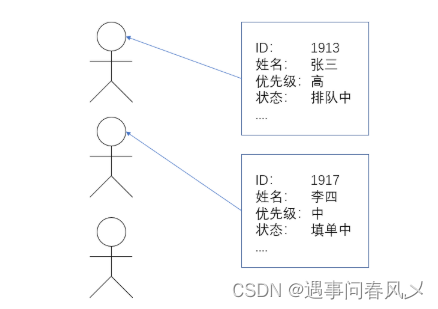
🌳Thread 的常见构造方法

使用如下:
Thread t1 = new Thread();
Thread t2 = new Thread(new MyRunnable());
Thread t3 = new Thread("这是我的名字");
Thread t4 = new Thread(new MyRunnable(), "这是我的名字");
命名操作:
- 是将你在使用 jconsole 命令观察线程时的看到的线程名改为你自己的重命名
比如有以下程序:
public class Test1 {
public static void main(String[] args) {
Thread thread = new Thread(()->{
while (true) {
System.out.println("我的名字叫遇事问春风乄");
try {
Thread.sleep(1000);
} catch (InterruptedException e) {
throw new RuntimeException(e);
}
}
},"遇事问春分乄");
thread.start();
while (true) {
System.out.println("我的名字叫main");
try {
Thread.sleep(1000);
} catch (InterruptedException e) {
throw new RuntimeException(e);
}
}
}
}
当我们用 jconsole 命令进行查看时,结果如下:
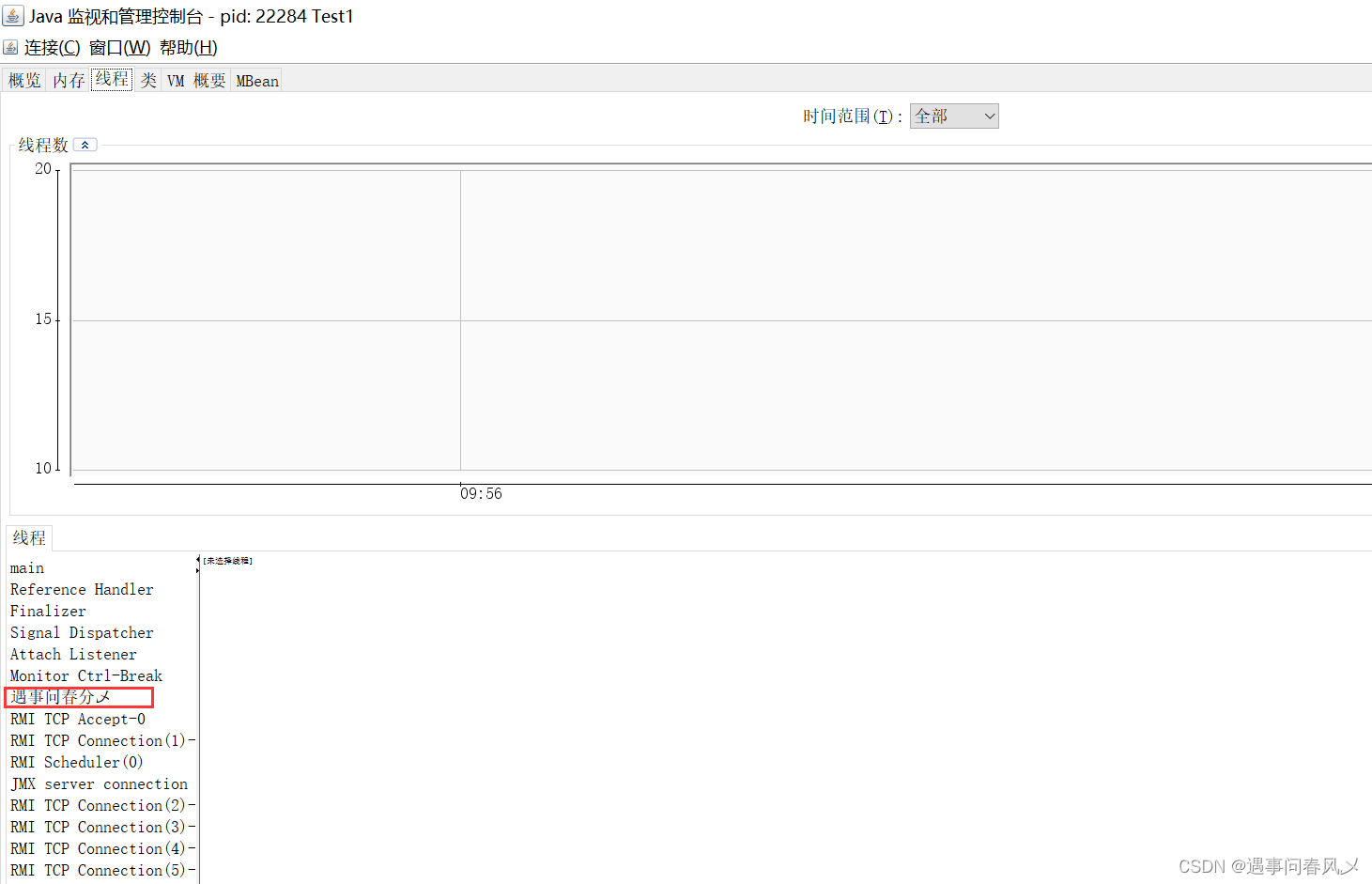
上面就会有我们自己的命名。
这样方便程序猿进行调试
🎄Thread 的几个常见属性
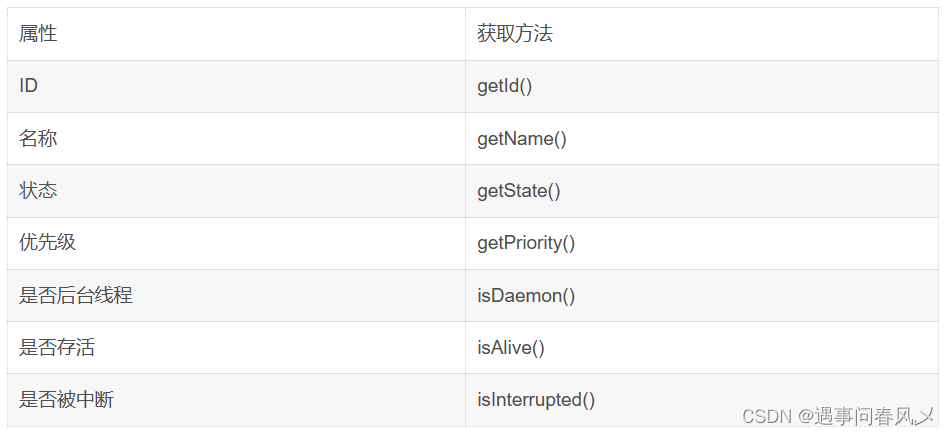
常见属性说明:
-
ID 是线程的唯一标识,不同线程不会重复
-
名称是各种调试工具用到
-
状态表示线程当前所处的一个情况,后面博主会一一介绍
-
优先级高的线程理论上来说更容易被调度到
-
关于后台线程,需要记住一点:JVM会在一个进程的所有非后台线程结束后,才会结束运行。
-
是否存活,即简单的理解,为 run 方法是否运行结束了
-
线程的中断问题,下面博主会进一步说明
程序举例,有以下程序(Thread.currentThread()表示返回当前线程对象的引用)
public class ThreadDemo {
public static void main(String[] args) {
Thread thread = new Thread(() -> {
for (int i = 0; i < 10; i++) {
try {
System.out.println(Thread.currentThread().getName() + ": 我还活着");
Thread.sleep(1 * 1000);
} catch (InterruptedException e) {
e.printStackTrace();
}
}
System.out.println(Thread.currentThread().getName() + ": 我即将死去");
},"遇事问春风乄");
System.out.println(Thread.currentThread().getName()
+ ": ID: " + thread.getId());
System.out.println(Thread.currentThread().getName()
+ ": 名称: " + thread.getName());
System.out.println(Thread.currentThread().getName()
+ ": 状态: " + thread.getState());
System.out.println(Thread.currentThread().getName()
+ ": 优先级: " + thread.getPriority());
System.out.println(Thread.currentThread().getName()
+ ": 后台线程: " + thread.isDaemon());
System.out.println(Thread.currentThread().getName()
+ ": 活着: " + thread.isAlive());
System.out.println(Thread.currentThread().getName()
+ ": 被中断: " + thread.isInterrupted());
thread.start();
while (thread.isAlive()) {}
System.out.println(Thread.currentThread().getName()
+ ": 状态: " + thread.getState());
}
}
运行结果如下:

🍀start()-启动一个线程
之前我们已经看到了如何通过覆写 run 方法创建一个线程对象,但线程对象被创建出来并不意味着线程就开始运行了。
-
覆写 run 方法是提供给线程要做的事情的指令清单
-
线程对象可以认为是张三把 李四、王五叫过来了
-
而调用 start() 方法,就是张三喊一声:”行动起来!“,线程才真正独立去执行了

调用 start 方法, 才真的在操作系统的底层创建出一个线程
🌲中断一个线程
李四一旦进到工作状态,他就会按照行动指南上的步骤去进行工作,不完成是不会结束的。但有时我们需要增加一些机制,例如老板突然来电话了,说转账的对方是个骗子,需要赶紧停止转账,那张三该如何通知李四停止呢?这就涉及到我们的停止线程的方式了。
目前常见的有以下两种方式:
-
通过共享的标记来进行沟通
-
调用 interrupt() 方法来通知
🚩实例一
使用自定义的变量来作为标志位.
- 需要给标志位上加 volatile 关键字(这个关键字的功能后面介绍,就暂时理解为一个共享的变量)
比如有以下程序:
public class ThreadDemo1 {
private static class MyRunnable implements Runnable {
public volatile boolean isQuit = false;
@Override
public void run() {
while (!isQuit) {
System.out.println(Thread.currentThread().getName()
+ ": 别管我,我忙着转账呢!");
try {
Thread.sleep(1000);
} catch (InterruptedException e) {
e.printStackTrace();
}
}
System.out.println(Thread.currentThread().getName()
+ ": 啊!险些误了大事");
System.out.println("停止转账");
}
}
public static void main(String[] args) throws InterruptedException {
MyRunnable target = new MyRunnable();
Thread thread = new Thread(target, "李四");
System.out.println(Thread.currentThread().getName()
+ ": 让李四开始转账。");
thread.start();
Thread.sleep(10 * 1000);
System.out.println(Thread.currentThread().getName()
+ ": 老板来电话了,得赶紧通知李四对方是个骗子!");
target.isQuit = true;
}
}
运行结果如下:
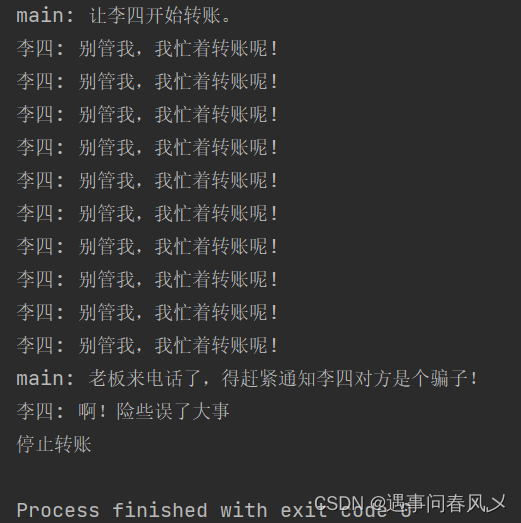
我们可以里看到当李四收到了受骗的通知后,停止了转账行为
🚩实例二
使用Thread.interrupted() 或者 Thread.currentThread().isInterrupted()代替自定义标志位.
Thread 内部包含了一个 boolean 类型的变量作为线程是否被中断的标记
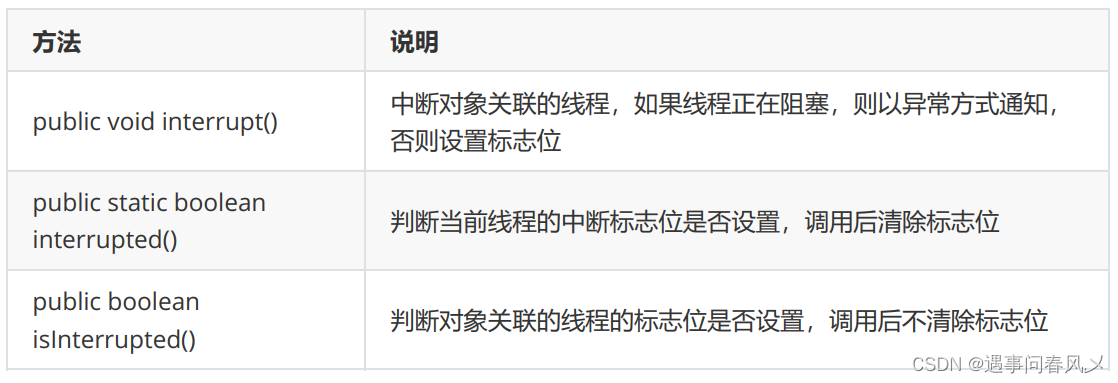
比如以下程序:
public class ThreadDemo2 {
private static class MyRunnable implements Runnable {
@Override
public void run() {
// 两种方法均可以
while (!Thread.interrupted()) {
//while (!Thread.currentThread().isInterrupted()) {
System.out.println(Thread.currentThread().getName()
+ ": 别管我,我忙着转账呢!");
try {
Thread.sleep(1000);
} catch (InterruptedException e) {
e.printStackTrace();
System.out.println(Thread.currentThread().getName()
+ ": 有内鬼,终止交易!");
// 注意此处的 break
break;
}
}
System.out.println(Thread.currentThread().getName()
+ ": 啊!险些误了大事");
}
}
public static void main(String[] args) throws InterruptedException {
MyRunnable target = new MyRunnable();
Thread thread = new Thread(target, "李四");
System.out.println(Thread.currentThread().getName()
+ ": 让李四开始转账。");
thread.start();
Thread.sleep(10 * 1000);
System.out.println(Thread.currentThread().getName()
+ ": 老板来电话了,得赶紧通知李四对方是个骗子!");
thread.interrupt();
}
}
运行结果如下:
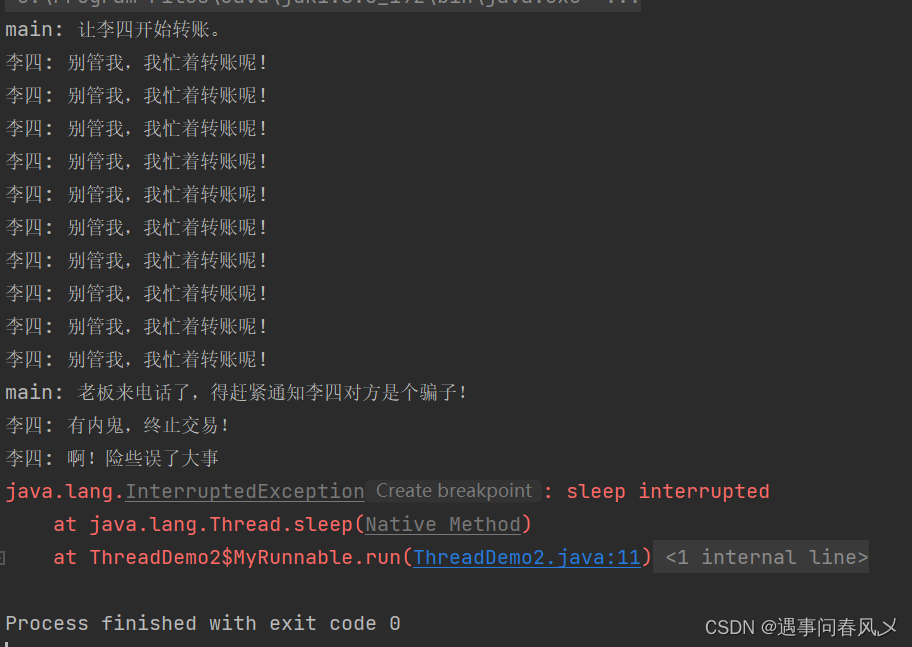
hread 收到通知的方式有两种:
- 如果线程因为调用 wait/join/sleep 等方法而阻塞挂起,则以InterruptedException 异常的形式通知,清除中断标志当出现InterruptedException 的时候, 要不要结束线程取决于 catch 中代码的写法. 可以选择忽略这个异常, 也可以跳出循环结束线程.
上述代码中,博主在catch里加了break,所以停止了交易,当我们去掉break时,效果如下:
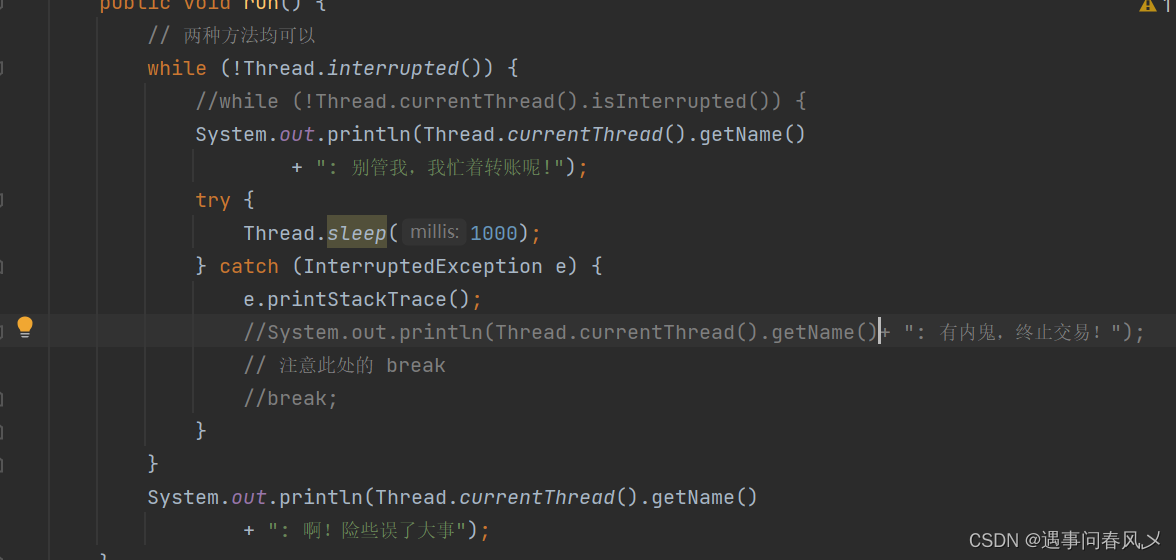
我们再来看一下运行结果:
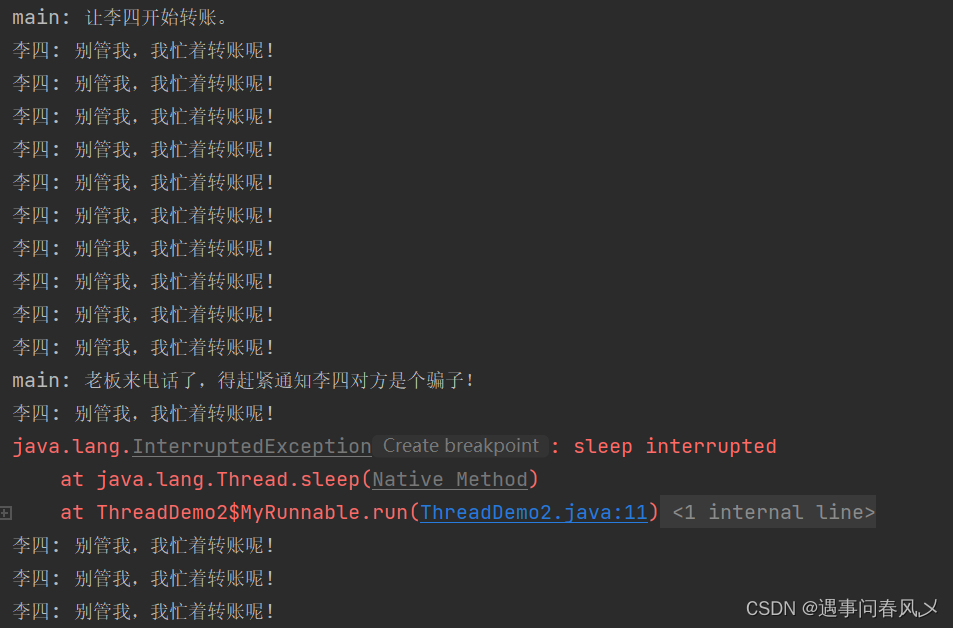
我们发现我们如果不去结束循环,该线程会在抛出异常后继续运行。
这就将主动权交到了我们程序员自己的手上,你通知归通知,停不停止是我自己的决定的
- 否则,只是内部的一个中断标志被设置,thread 可以通过
-
Thread.interrupted() 判断当前线程的中断标志被设置,清除中断标志
-
Thread.currentThread().isInterrupted() 判断指定线程的中断标志被设置,不清除中断标志
这种方式通知收到的更及时,即使线程正在 sleep 也可以马上收到
🚩实例三
观察标志位是否清除
标志位是否清除, 就类似于一个开关.
- Thread.interrupted() 相当于按下开关, 开关自动弹起来了. 这个称为 “清除标志位”
- Thread.currentThread().isInterrupted() 相当于按下开关之后, 开关弹不起来, 这个称为 “不清除标志位”
- 使用 Thread.interrupted() , 线程中断会清除标志位
代码如下:
public class ThreadDemo3 {
private static class MyRunnable implements Runnable {
@Override
public void run() {
for (int i = 0; i < 10; i++) {
System.out.println(Thread.interrupted());
}
}
}
public static void main(String[] args) throws InterruptedException {
MyRunnable target = new MyRunnable();
Thread thread = new Thread(target, "李四");
thread.start();
thread.interrupt();
}
}
运行结果为:
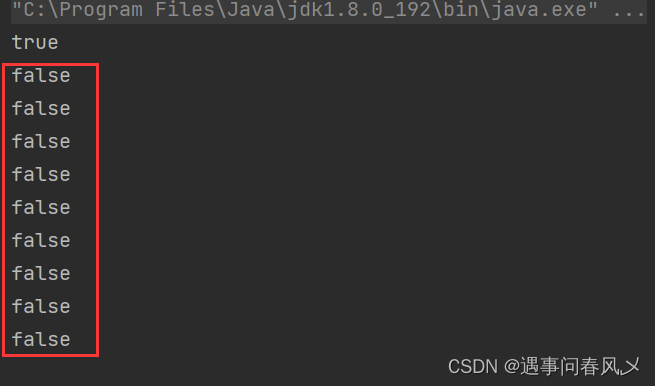
- 使用 Thread.currentThread().isInterrupted() , 线程中断标记位不会清除.
代码如下:
public class ThreadDemo4 {
private static class MyRunnable implements Runnable {
@Override
public void run() {
for (int i = 0; i < 10; i++) {
System.out.println(Thread.currentThread().isInterrupted());
}
}
}
public static void main(String[] args) throws InterruptedException {
MyRunnable target = new MyRunnable();
Thread thread = new Thread(target, "李四");
thread.start();
thread.interrupt();
}
}
运行结果如下:
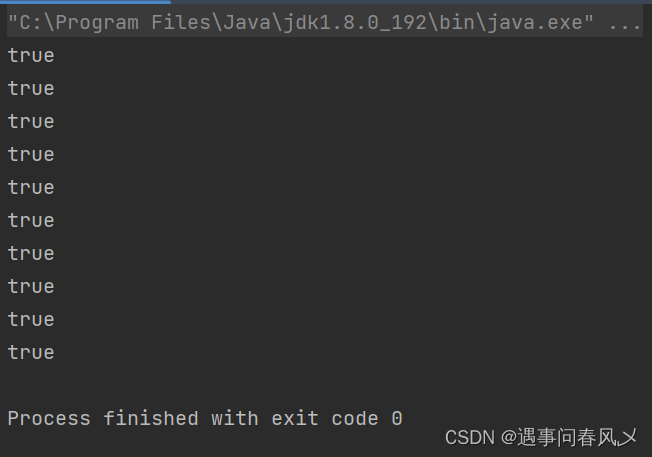
🎍join()-等待一个线程
有时,我们需要等待一个线程完成它的工作后,才能进行自己的下一步工作。
例如,张三只有等李四转账成功,才决定是否存钱,这时我们需要一个方法明确等待线程的结束
代码示例如下:
public class ThreadDemo5 {
public static void main(String[] args) throws InterruptedException {
Runnable target = () -> {
for (int i = 0; i < 3; i++) {
try {
System.out.println(Thread.currentThread().getName()
+ ": 我还在工作!");
Thread.sleep(1000);
} catch (InterruptedException e) {
e.printStackTrace();
}
}
System.out.println(Thread.currentThread().getName() + ": 我结束了!");
};
Thread thread1 = new Thread(target, "李四");
Thread thread2 = new Thread(target, "王五");
System.out.println("先让李四开始工作");
thread1.start();
thread1.join();
System.out.println("李四工作结束了,让王五开始工作");
thread2.start();
thread2.join();
System.out.println("王五工作结束了");
}
}
运行结果为:
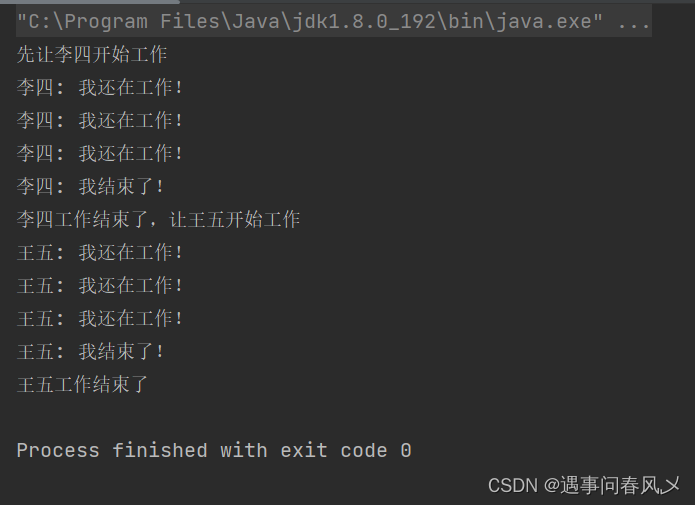
上述只是一个简单的应用,join()还提供了其他方法

关于 join 还有一些细节内容,博主会在后面的章节进行讲述
🚩获取当前线程引用
这个方法我们以及非常熟悉了,前面都已经使用过了,就不做过多赘述了
| public static Thread currentThread(); | 返回当前线程对象的引用 |
|---|
🚩休眠当前线程
也是我们比较熟悉一组方法,有一点要记得,因为线程的调度是不可控的,所以,这个方法只能保证实际休眠时间是大于等于参数设置的休眠时间的。
| public static void sleep(long millis) throws InterruptedException | 休眠当前线程 millis毫秒 |
|---|---|
| public static void sleep(long millis, int nanos) throwsInterruptedException | 可以更高精度的休眠 |
关于 sleep,以后博主还会有一些知识会给大家补充的。
⭕总结
关于《【JavaEE初阶】 Thread类及常见方法》就讲解到这儿,感谢大家的支持,欢迎各位留言交流以及批评指正,如果文章对您有帮助或者觉得作者写的还不错可以点一下关注,点赞,收藏支持一下!























 1228
1228

 被折叠的 条评论
为什么被折叠?
被折叠的 条评论
为什么被折叠?










